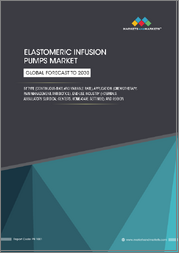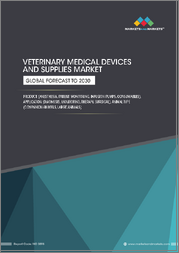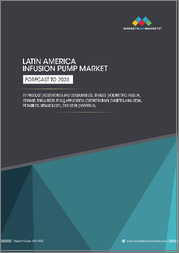
|
시장보고서
상품코드
1804713
혈관 압박 밴드 시장 : 메커니즘, 제품 유형, 소재 유형, 용도, 최종사용자, 유통 채널별 - 세계 예측(2025-2030년)Vascular Compression Band Market by Mechanism, Product Type, Material Type, Application, End User, Distribution Channel - Global Forecast 2025-2030 |
||||||
혈관 압박 밴드 시장은 2024년에는 9억 3,159만 달러로 평가되었으며, 2025년에는 9억 8,935만 달러, CAGR 6.55%로 성장하여 2030년에는 13억 6,391만 달러에 달할 것으로 예측됩니다.
| 주요 시장 통계 | |
|---|---|
| 기준 연도 2024년 | 9억 3,159만 달러 |
| 추정 연도 2025년 | 9억 8,935만 달러 |
| 예측 연도 2030년 | 13억 6,391만 달러 |
| CAGR(%) | 6.55% |
혈관 압박 밴드는 다양한 환자군에 대해 순환 기능을 개선하고 혈전 발생 위험을 줄이기 위해 표적화된 지원을 제공함으로써 임상 및 재택 간호 환경 모두에서 필수적인 치료 장비로 부상하고 있습니다. 지난 10년간 재료 과학, 인체공학적 디자인, 디지털 연결의 급속한 발전으로 인해 이러한 밴드의 효과와 편안함이 향상되어 의료 전문가와 최종사용자들 사이에서 널리 채택되고 있습니다. 비침습적 개입과 환자 중심 치료가 의료 현장에서 점점 더 우선순위가 높아지고 있는 가운데, 이러한 압박 솔루션은 예방 및 재활 프로토콜의 최전선에 자리 잡고 있습니다. 따라서 각 제조사들은 연구개발에 많은 투자를 하고 있으며, 센서의 통합과 적응형 압력 제어를 강화하여 차별화를 꾀하고 있습니다. 또한, 진화하는 상환 프레임워크와 근거에 기반한 임상 가이드라인은 종합적인 치료 요법에서 혈관 압박의 전략적 중요성을 지속적으로 강조하고 있습니다.
이 주요 요약은 현대 의학에서 혈관 압박 장치의 중요한 역할에 대한 전략적 관점을 제공하고, 시장의 힘과 기술 혁신 사이의 역동적인 상호 작용을 강조합니다. 업계의 주요 발전, 경쟁 역학, 규제의 영향을 종합적으로 요약하고 이해관계자가 새로운 데이터를 활용하여 제품 포트폴리오를 최적화할 수 있는 방법에 대한 간결하고 종합적인 견해를 독자에게 제공합니다. 또한, 환자 인구통계학적 변화와 예방의학에 대한 관심이 높아짐에 따라 임상적 결과와 비용 효율성을 모두 향상시킬 수 있는 기회를 모색하고 있습니다. 이 분석을 통해 의사결정자는 진화하는 수요 패턴과 시장 진입의 잠재적 장벽을 명확하게 파악할 수 있습니다.
이 요약은 복잡한 동향을 실용적인 인텔리전스로 추출하여 주요 요약이 공급망 복원력, 가격 전략, 유통 채널의 변화를 예측할 수 있도록 합니다. 또한, 전략적 우선순위와 실제 업무적 고려사항을 일치시키는 로드맵 역할을 하며, 정보에 입각한 투자 결정과 지속가능한 혁신을 촉진합니다. 궁극적으로, 이 개요서는 업계 리더들이 빠르게 변화하는 상황을 극복하고 혈관 압박요법에서 탁월한 가치를 제공하는 데 필요한 인사이트를 제공할 것입니다.
혈관 압박 솔루션의 미래를 형성하는 획기적인 기술 혁신과 진화하는 헬스케어 패러다임에 대해 알아봅니다.
최근 몇 년 동안 기술 혁신과 임상적 인사이트이 크게 융합되면서 혈관 압박의 전망이 재정의되고 있습니다. 스마트 패브릭, 내장 센서 및 무선 연결은 기본 압박 밴드를 실시간 모니터링 및 적응형 압력 조절이 가능한 지능형 치료 시스템으로 바꾸어 놓았습니다. 이러한 생체역학과 데이터 분석의 융합은 개인화된 치료 프로토콜을 가능하게 하고, 동적 피드백을 통해 순응도를 강화하여 환자 참여와 임상적 효과를 높입니다. 또한, 적층 가공과 지속가능한 재료의 발전으로 인해 환경에 미치는 영향을 줄이면서 제품의 반복 주기가 빨라지고 있습니다.
미국의 새로운 관세가 혈관압박대 수입 및 국내 공급망에 미치는 종합적인 영향 분석
2025년, 의료기기 수입에 대한 종합적인 관세 조치의 도입은 혈관 압박 밴드 시장에 큰 압력을 가하여 이해관계자들이 조달 전략과 가격 모델을 재평가하도록 촉구했습니다. 첨단 폴리머, 센서 모듈 등 주요 부품에 추가 관세가 부과되면서 세계 공급망에 의존하는 기업의 제조 비용이 상승했습니다. 그 결과, 많은 제조업체들이 마진 제약에 직면하여 대체 재료 공급업체를 찾거나 전략적 가격 조정을 통해 비용 증가분의 일부를 흡수할 수밖에 없는 상황에 직면해 있습니다.
압박대 유형별, 용도별, 최종사용자별 시장 역학에 대한 주요 세분화 인사이트를 제공합니다.
장비 유형별로 시장 세분화를 자세히 살펴보면, 압착 방식에 따라 서로 다른 가치 제안이 드러납니다. 간헐적 공기압박 시스템은 자연 혈류를 모방한 연속적인 팽창 사이클을 제공하는 멀티 챔버 구성과 특정 사지 부위를 대상으로 비용 효율적인 압박을 제공하는 단일 챔버 모델을 통해 치료 효과를 선도하고 있습니다. 순차적 팽창형 압박 밴드는 정맥 환류를 최적화하는 단계별 압력 프로파일을 제공하며, 정적 압박 밴드는 탄성 소재를 활용하여 치료 압력을 일정하게 유지하여 장기적인 관리 시나리오와 예민도가 낮은 용도에 적합합니다.
아메리카, 유럽, 중동 및 아프리카, 아시아태평양의 주요 지역별 실적 동향을 파악하고 전략적 고려에 도움을 드립니다.
아메리카의 혈관 압박 밴드 시장은 강력한 의료 인프라와 비침습적 치료법을 지원하는 선진적인 규제 환경에 힘입어 견고한 수요가 특징입니다. 특히 미국은 종합병원 시스템과 재택의료 제공자가 상환 경로를 활용하여 조기 동원 프로토콜을 추진하고, 기술 혁신의 도입을 주도하고 있습니다. 한편, 캐나다와 멕시코는 지역 기업이 일반 시민을 대상으로 한 인식 제고 캠페인에 투자하고 고도로 압축된 시스템의 국경 간 공급망을 간소화하고 있기 때문에 꾸준한 성장세를 보이고 있습니다.
혈관 압박 밴드의 혁신과 시장 경쟁에서 차별화를 주도하는 저명한 시장 리더와 그들의 전략적 접근 방식을 소개합니다.
혈관 압박 밴드 분야의 주요 기업들은 기술 혁신에 대한 집중적인 투자, 전략적 파트너십, 세계 사업 확장을 통해 차별화를 꾀하고 있습니다. 한 대형 제조업체는 보완적인 기술 기업을 인수하여 시장 지위를 강화하고 지능형 센서 어레이와 자체 압력 제어 알고리즘을 제품군에 통합했습니다. 또 다른 대기업은 학술 기관과 협력 관계를 맺고 임상 효과를 검증하고 여러 지역에서 주요 상환 지정을 확보하기 위해 노력하고 있습니다.
압박 치료 분야에서 시장 입지를 강화하고 새로운 기회를 활용하기 위해 업계 리더들에게 실행 가능한 전략적 제안을 제공합니다.
혈관 압박 밴드 시장에서 새로운 기회를 활용하기 위해 업계 리더들은 개인화된 환자 경험과 실시간 데이터 모니터링을 가능하게 하는 스마트 기술 통합을 우선순위에 두어야 합니다. 커넥티드 센서를 통합하고 클라우드 기반 애널리틱스를 활용함으로써 기업은 결과 중심 치료 모델에서 명확한 가치를 입증하고 유리한 상환 범위를 확보할 수 있습니다. 또한, 원격의료 제공자 및 디지털 헬스 플랫폼과의 전략적 제휴를 통해 재택 진료 환경으로 도달 범위를 확장하고 원활한 환자 참여를 촉진할 수 있습니다.
혈관 압박 밴드의 시장 역학 및 인사이트 생성에 대한 종합적인 분석을 뒷받침하는 엄격한 연구 방법론에 대한 자세한 내용.
본 보고서에서 소개되는 조사 결과는 종합적인 2차 조사와 타겟팅된 1차 인터뷰가 결합된 엄격한 조사 방법을 통해 도출된 것입니다. 학술지, 업계 간행물, 규제 데이터베이스, 기업 제출 서류 등 2차 자료는 시장 역학, 기술 발전, 정책 상황에 대한 기초적인 이해를 제공했습니다. 이러한 동향은 주요 오피니언 리더, 기기 제조업체, 의료 서비스 제공자, 유통 파트너와의 1차 인터뷰를 통해 보완되어 데이터 포인트를 검증하고 새로운 동향을 파악하는 데 도움이 되었습니다.
시장 역학의 본질을 파악하고, 이해관계자의 전략적 의사결정을 이끄는 분석에서 결정적인 인사이트를 이끌어냅니다.
혈관 압박 밴드 시장이 계속 진화하는 가운데, 기술의 발전, 정책의 변화, 치료 패러다임의 변화가 교차하는 가운데, 전략적 선견지명이 매우 중요하다는 것을 알 수 있습니다. 스마트 압착 시스템의 혁신에서 관세 정책의 파급 효과에 이르기까지 업계 참가자들은 다양한 부문에서 가치를 창출하기 위해 민첩하고 적극적인 자세를 유지해야 합니다. 세분화 분석은 스포츠 부상 예방 및 재택 치료 환경과 같은 분야에서 미개척 잠재력을 강조하고, 지역별 인사이트는 아메리카, 유럽, 중동 및 아프리카, 아시아태평양에서 차별화된 성장 궤도를 보여줍니다.
목차
제1장 서문
제2장 조사 방법
제3장 주요 요약
제4장 시장 개요
제5장 시장 역학
제6장 시장 인사이트
- Porter's Five Forces 분석
- PESTEL 분석
제7장 미국 관세의 누적 영향 2025
제8장 혈관 압박 밴드 시장 : 기구별
- 간헐적 공기 압박
- 멀티 챔버
- 단일 챔버
- 순차 압박 밴드
- 정적 압박 밴드
제9장 혈관 압박 밴드 시장 : 제품 유형별
- 신축성 및 조절성 압박 밴드
- 비탄성 및 경질 압박 밴드
제10장 혈관 압박 밴드 시장 : 소재 유형별
- 면 직물
- 폴리우레탄
- 실리콘
제11장 혈관 압박 밴드 시장 : 용도별
- 심부정맥혈전증 예방
- 림프부종 관리
- 수술 후 회복
- 스포츠 부상 예방
제12장 혈관 압박 밴드 시장 : 최종사용자별
- 클리닉
- 재택 케어 설정
- 병원
- 스포츠 시설
제13장 혈관 압박 밴드 시장 : 유통 채널별
- 직접 판매
- 판매대리점
- 온라인 플랫폼
제14장 아메리카의 혈관 압박 밴드 시장
- 미국
- 캐나다
- 멕시코
- 브라질
- 아르헨티나
제15장 유럽, 중동 및 아프리카의 혈관 압박 밴드 시장
- 영국
- 독일
- 프랑스
- 러시아
- 이탈리아
- 스페인
- 아랍에미리트
- 사우디아라비아
- 남아프리카공화국
- 덴마크
- 네덜란드
- 카타르
- 핀란드
- 스웨덴
- 나이지리아
- 이집트
- 튀르키예
- 이스라엘
- 노르웨이
- 폴란드
- 스위스
제16장 아시아태평양의 혈관 압박 밴드 시장
- 중국
- 인도
- 일본
- 호주
- 한국
- 인도네시아
- 태국
- 필리핀
- 말레이시아
- 싱가포르
- 베트남
- 대만
제17장 경쟁 구도
- 시장 점유율 분석, 2024
- FPNV 포지셔닝 매트릭스, 2024
- 경쟁 분석
- Advin Health Care
- Merit Medical Systems, Inc.
- Advanced Vascular Dynamics
- AnsCare by BenQ Materials Corporation
- Beijing Demax Medical Technology Co., Ltd.
- Boen Healthcare Co., Ltd.
- DeRoyal Industries, Inc.
- Forge Medical
- JCR Medical
- Lepu Medical Technology(Beijing) Co.,Ltd.
- Stryker Corporation
- Tabeeb Vascular Co.
- Teleflex Incorporated
- Terumo Corporation
- Tricol Biomedical, Inc.
- TZ Medical, Inc.
제18장 리서치 AI
제19장 리서치 통계
제20장 리서치 컨택트
제21장 리서치 기사
제22장 부록
KSM 25.09.11The Vascular Compression Band Market was valued at USD 931.59 million in 2024 and is projected to grow to USD 989.35 million in 2025, with a CAGR of 6.55%, reaching USD 1,363.91 million by 2030.
| KEY MARKET STATISTICS | |
|---|---|
| Base Year [2024] | USD 931.59 million |
| Estimated Year [2025] | USD 989.35 million |
| Forecast Year [2030] | USD 1,363.91 million |
| CAGR (%) | 6.55% |
Vascular compression bands have emerged as indispensable therapeutic devices in both clinical and home care environments, offering targeted support to improve circulatory function and reduce the risk of thrombotic events for diverse patient populations. Over the past decade, rapid advancements in material science, ergonomic design, and digital connectivity have elevated the efficacy and comfort of these bands, driving widespread adoption among healthcare professionals and end users. As the healthcare landscape increasingly prioritizes non-invasive interventions and patient-centered care, these compression solutions are positioned at the forefront of preventative and rehabilitative protocols. Consequently, manufacturers are investing heavily in research and development to differentiate their offerings through enhanced sensor integration and adaptive pressure control. Moreover, evolving reimbursement frameworks and evidence-based clinical guidelines continue to underscore the strategic importance of vascular compression in comprehensive treatment regimens.
This executive summary provides a strategic vantage point on the critical role of vascular compression devices in modern medicine and highlights the dynamic interplay between market forces and technological innovation. It synthesizes key industry developments, competitive dynamics, and regulatory influences, offering readers a concise yet comprehensive view of how stakeholders can leverage emerging data to optimize product portfolios. Additionally, it explores the implications of shifting patient demographics and growing emphasis on preventative care, illuminating opportunities to enhance both clinical outcomes and cost-effectiveness. Through this analysis, decision makers can gain clarity on evolving demand patterns and potential barriers to market entry.
By distilling complex trends into actionable intelligence, this summary empowers executives to anticipate shifts in supply chain resilience, pricing strategies, and distribution channels. It serves as a roadmap for aligning strategic priorities with real-world operational considerations, fostering informed investment decisions and sustainable innovation. Ultimately, this overview equips industry leaders with the insights needed to navigate a rapidly evolving landscape and deliver superior value in vascular compression therapy
Exploring Groundbreaking Technological Innovations and Evolving Healthcare Paradigms That Are Reshaping the Future of Vascular Compression Solutions
Recent years have witnessed a remarkable convergence of technological innovation and clinical insights that is redefining the vascular compression landscape. Smart fabrics, embedded sensors, and wireless connectivity have transformed basic compression bands into intelligent therapeutic systems capable of real-time monitoring and adaptive pressure modulation. This fusion of biomechanics and data analytics enables personalized treatment protocols and enhances compliance through dynamic feedback, thereby elevating patient engagement and clinical efficacy. Furthermore, advancements in additive manufacturing and sustainable materials have accelerated product iteration cycles while reducing environmental impact.
Simultaneously, the healthcare sector is undergoing a paradigm shift toward decentralized care models and value-based reimbursement structures. Telehealth platforms and remote patient monitoring solutions are now integral to post-operative recovery and chronic condition management, extending the reach of vascular compression therapies beyond traditional hospital settings. As payer systems emphasize outcome-oriented metrics, manufacturers and providers alike are compelled to demonstrate measurable improvements in patient quality of life and cost containment. Moreover, collaborative partnerships between device makers, technology firms, and research institutions are fostering an ecosystem that rewards innovation through shared data and co-development initiatives.
Consequently, these transformative shifts are reshaping both product design and market access strategies. Companies are reimagining distribution networks to encompass digital health channels and direct-to-consumer models, while also integrating advanced analytics into clinical decision support tools. This integrated approach not only enhances the value proposition for end users but also positions stakeholders to respond nimbly to evolving regulatory requirements and competitive pressures. By embracing these disruptive trends, industry participants can unlock sustainable growth pathways and deliver next-generation vascular compression solutions
Analyzing the Overarching Effects of Newly Implemented United States Tariffs on Vascular Compression Band Imports and Domestic Supply Chains
In 2025, the introduction of comprehensive tariff measures on medical device imports has exerted significant pressure on the vascular compression band market, prompting stakeholders to reevaluate sourcing strategies and pricing models. The imposition of additional duties on key components, including advanced polymers and sensor modules, has elevated production costs for companies reliant on global supply chains. Consequently, many manufacturers are confronting margin constraints, compelling them to explore alternative material suppliers or to absorb a portion of the increased costs through strategic price adjustments.
Moreover, the tariff landscape has catalyzed a shift toward localized manufacturing and assembly operations within the United States. Companies with sufficient capital reserves have expedited investments in domestic facilities to mitigate future exposure to import levies and to streamline logistics. This localization effort not only reduces lead times but also enhances supply chain resilience in the face of trade policy volatility. However, smaller enterprises may face capital intensity barriers, potentially widening the competitive gap between established market leaders and emerging players.
Transitioning through these challenges has underscored the importance of robust risk mitigation frameworks and flexible procurement practices. In response, organizations are seeking diversified supplier ecosystems across multiple geographies to cushion against tariff fluctuations. Additionally, collaborative negotiations with customs authorities and strategic utilization of free trade zones are emerging as vital tactics to preserve cost competitiveness. Ultimately, the cumulative effects of the 2025 tariff regimen have accelerated innovation in supply chain management and underscored the strategic imperative of balancing cost efficiency with regulatory compliance
Unveiling Key Segmentation Insights That Illuminate Market Dynamics Across Type Application and End User Dimensions of Compression Band Usage
A closer examination of market segmentation by device type reveals distinct value propositions for each compression modality. Intermittent pneumatic compression systems continue to lead in therapeutic efficacy, with multi-chamber configurations offering sequential inflation cycles that mimic natural blood flow and single-chamber models providing cost-effective, targeted compression for specific limb segments. Sequential compression bands deliver graduated pressure profiles that optimize venous return, while static compression bands leverage elastic materials to maintain constant therapeutic pressure, catering to long-term management scenarios and lower acuity applications.
In terms of clinical applications, deep vein thrombosis prevention remains the primary driver of adoption, particularly in inpatient surgical settings where prophylactic protocols are mandated. Lymphatic edema management markets have expanded in parallel, fueled by growing awareness of non-invasive lymphedema therapies following oncological treatments. Post-surgical recovery applications are gaining traction as multimodal care pathways emphasize early mobilization and reduced hospital stays. Additionally, sports injury prevention is emerging as a dynamic segment, with athletes and trainers leveraging compression bands to support rehabilitation and minimize downtime.
From an end-user perspective, hospitals and acute care centers represent the largest share of demand, driven by strict regulatory standards and high patient volumes. Clinics, including ambulatory surgical centers and outpatient facilities, are adopting portable compression devices to streamline patient throughput and enhance recovery protocols. The home care segment, encompassing both community-based centers and individual households, is witnessing accelerated growth as telehealth integration and device portability facilitate at-home usage. Sports facilities, ranging from professional teams to fitness studios, are also capitalizing on the wellness trend by incorporating compression bands into performance and therapeutic regimens.
Revealing Critical Regional Performance Trends in the Americas Europe Middle East and Africa as Well as Asia Pacific for Strategic Consideration
Across the Americas, the vascular compression band market is characterized by robust demand driven by strong healthcare infrastructure and a progressive regulatory environment that supports non-invasive therapeutic modalities. The United States, in particular, leads innovation adoption, with integrated hospital systems and home healthcare providers leveraging reimbursement pathways to promote early mobilization protocols. Meanwhile, Canada and Mexico are experiencing steady growth as regional players invest in public awareness campaigns and streamline cross-border supply chains for advanced compression systems.
Europe, the Middle East, and Africa present a heterogeneous landscape marked by varied reimbursement frameworks and divergent levels of clinical adoption. Western European markets benefit from well-established reimbursement models that incentivize use of evidence-based prophylactic devices, while emerging economies in Eastern Europe and the Middle East are witnessing gradual uptake fueled by expanding private healthcare spending. Africa remains under-penetrated but holds significant potential as international health initiatives prioritize thrombosis prevention in high-risk populations, creating opportunities for public-private partnerships and philanthropic distribution programs.
In the Asia-Pacific region, rapid urbanization and increasing healthcare investments are propelling market expansion. Advanced economies such as Japan and Australia continue to drive high-end device demand, supported by aging populations and stringent clinical guidelines. Meanwhile, China and India are emerging as both consumption hubs and manufacturing powerhouses, leveraging lower labor costs and government incentives to scale production. Southeast Asian markets are also gaining momentum, as local distributors collaborate with global brands to introduce portable and cost-effective compression solutions tailored to regional healthcare delivery models.
Highlighting Prominent Market Leaders and Their Strategic Approaches Driving Innovation and Competitive Differentiation in Vascular Compression Bands
Major players in the vascular compression band arena are distinguishing themselves through targeted investment in innovation, strategic partnerships, and expanded global footprints. One leading manufacturer has reinforced its market position by acquiring complementary technology firms, thereby integrating intelligent sensor arrays and proprietary pressure control algorithms into its product suite. Another prominent company has formed collaborative alliances with academic institutions to validate clinical efficacy and secure key reimbursement designations in multiple geographies.
In addition, some well-established medical device companies are broadening their portfolios through the introduction of modular compression systems that cater to both acute and chronic care settings. These firms are leveraging robust distribution networks and after-sales support infrastructures to enhance customer retention and facilitate rapid market entry in developing regions. At the same time, regional specialists are capitalizing on local manufacturing capabilities to offer cost-competitive alternatives, focusing on high-volume channels such as home healthcare providers and direct-to-consumer sales.
Smaller innovators with niche expertise in digital health are also gaining traction by offering cloud-based analytics platforms that aggregate patient compliance and treatment efficacy data. By combining hardware and software, these agile companies are creating comprehensive therapeutic ecosystems that appeal to health systems aiming to meet value-based care benchmarks.
Furthermore, regulatory agility is emerging as a critical differentiator among top competitors. Enterprises that proactively engage with regulatory bodies to secure expedited approvals for next-generation compression solutions are achieving accelerated time-to-market advantages. These companies complement their regulatory strategies with robust quality management systems, ensuring compliance across multiple jurisdictions and reinforcing customer confidence. Consequently, industry leadership is increasingly defined by the ability to align product innovation with evolving global regulatory standards.
Providing Actionable Strategic Recommendations for Industry Leaders to Enhance Market Positioning and Capitalize on Emerging Opportunities in Compression Therapy
To capitalize on emerging opportunities within the vascular compression band market, industry leaders should prioritize the integration of smart technologies that enable personalized patient experiences and real-time data monitoring. By embedding connected sensors and leveraging cloud-based analytics, companies can demonstrate clear value in outcome-driven care models and secure favorable reimbursement coverage. Additionally, forging strategic alliances with telehealth providers and digital health platforms can expand reach into home care settings and facilitate seamless patient engagement.
Furthermore, optimizing supply chain resilience through diversified manufacturing footprints will mitigate risks associated with trade policy fluctuations and raw material shortages. Establishing regional production hubs and fostering long-term partnerships with suppliers in key geographies can ensure consistent product availability and cost stability. Equally important is the adoption of sustainable materials and eco-friendly packaging, which not only address growing environmental concerns but also enhance corporate social responsibility profiles.
Finally, stakeholders should invest in ongoing clinical research collaborations to generate robust evidence for the efficacy and safety of novel compression therapies. By publishing peer-reviewed studies and participating in global standardization efforts, companies can reinforce credibility and influence guideline development. Integrating customer feedback loops into product development processes will further refine user-centric design features and strengthen market differentiation. Collectively, these targeted actions will position industry participants to drive both short-term gains and long-term sustainable growth
Detailing the Rigorous Research Methodology Underpinning Comprehensive Analysis of Vascular Compression Band Market Dynamics and Insights Generation
The findings presented in this report are underpinned by a rigorous research methodology that combines comprehensive secondary research with targeted primary interviews. Secondary sources, including peer-reviewed journals, industry publications, regulatory databases, and company filings, provided a foundational understanding of market dynamics, technological advancements, and policy landscapes. These insights were complemented by primary interviews with key opinion leaders, device manufacturers, healthcare providers, and distribution partners to validate data points and capture emerging trends.
Data triangulation techniques were employed to reconcile discrepancies across multiple sources and ensure the integrity of our analysis. Quantitative data from public filings and proprietary databases were cross-referenced against qualitative insights from stakeholder discussions, enabling a holistic view of competitive strategies and market drivers. Furthermore, midpoint validation sessions with industry experts provided critical feedback on preliminary findings, enhancing the accuracy and relevance of our conclusions.
To structure the research process, a multi-tiered approach was adopted, encompassing market segmentation analysis, regional assessment, competitive landscape profiling, and regulatory impact evaluation. Each segment underwent rigorous scrutiny through scenario analysis and sensitivity testing to account for potential market disruptions. The final report encapsulates these efforts in a cohesive narrative, offering end-to-end transparency on research design, data collection methods, and analytical frameworks. Consequently, readers can have confidence in the robustness of the insights and the strategic guidance provided
Drawing Conclusive Insights from the Analysis to Capture the Essence of Market Dynamics and Guide Strategic Decision Making for Stakeholders
As the vascular compression band market continues to evolve, the intersection of technological advancement, policy shifts, and changing care paradigms underscores the critical need for strategic foresight. From innovations in smart compression systems to the ripple effects of tariff policies, industry participants must remain agile and proactive to capture value across diverse segments. The segmentation analysis highlights untapped potential in areas such as sports injury prevention and home care settings, while regional insights reveal differentiated growth trajectories across the Americas, Europe, Middle East & Africa, and Asia-Pacific.
Moreover, the competitive landscape is defined by a mix of established global players and nimble innovators, each pursuing unique strategies to gain market share. Whether through localized manufacturing, digital health integration, or strategic partnerships, successful companies are those that align operational capabilities with emerging clinical and regulatory requirements. These insights underscore the importance of collaborative ecosystems that bring together manufacturers, technology providers, and care delivery organizations.
Ultimately, this executive summary provides a consolidated overview of the forces shaping the vascular compression band market and outlines strategic imperatives for sustainable growth. By leveraging the actionable insights and recommendations herein, stakeholders can refine their strategic roadmaps, optimize resource allocation, and accelerate innovation pipelines. In doing so, they will be well-positioned to deliver superior patient outcomes and drive enduring competitive advantage in an increasingly dynamic healthcare environment
Table of Contents
1. Preface
- 1.1. Objectives of the Study
- 1.2. Market Segmentation & Coverage
- 1.3. Years Considered for the Study
- 1.4. Currency & Pricing
- 1.5. Language
- 1.6. Stakeholders
2. Research Methodology
- 2.1. Define: Research Objective
- 2.2. Determine: Research Design
- 2.3. Prepare: Research Instrument
- 2.4. Collect: Data Source
- 2.5. Analyze: Data Interpretation
- 2.6. Formulate: Data Verification
- 2.7. Publish: Research Report
- 2.8. Repeat: Report Update
3. Executive Summary
4. Market Overview
- 4.1. Introduction
- 4.2. Market Sizing & Forecasting
5. Market Dynamics
- 5.1. Emerging smart compression bands with integrated pressure sensors and Bluetooth connectivity for real-time patient monitoring
- 5.2. Development of eco-friendly reusable vascular compression wraps using advanced sustainable textile materials
- 5.3. Increasing collaboration between medical device manufacturers and textile firms on breathable compression fabrics
- 5.4. Rising adoption of home-based compression therapy devices driven by telehealth and remote patient monitoring services
- 5.5. Surge in demand for adjustable compression bands offering multi-point pneumatic control for DVT prophylaxis
- 5.6. Growth of sports-specific vascular compression sleeves designed to enhance athletic performance and prevent injuries
- 5.7. Regulatory approvals for novel elastomeric materials in vascular compression products improving patient comfort and compliance
- 5.8. Expansion of pediatric and geriatric tailored compression band designs addressing age-specific anatomical and clinical needs
- 5.9. Integration of AI-driven algorithms in compression band systems for personalized therapy adjustment based on patient data
- 5.10. Emergence of IoT-enabled vascular compression bands supporting cloud-based data analytics and clinician dashboards
6. Market Insights
- 6.1. Porter's Five Forces Analysis
- 6.2. PESTLE Analysis
7. Cumulative Impact of United States Tariffs 2025
8. Vascular Compression Band Market, by Mechanism
- 8.1. Introduction
- 8.2. Intermittent Pneumatic Compression
- 8.2.1. Multi Chamber
- 8.2.2. Single Chamber
- 8.3. Sequential Compression Band
- 8.4. Static Compression Band
9. Vascular Compression Band Market, by Product Type
- 9.1. Introduction
- 9.2. Elastic & Adjustable Compression Bands
- 9.3. Non-elastic & Rigid Compression Bands
10. Vascular Compression Band Market, by Material Type
- 10.1. Introduction
- 10.2. Cotton fabric
- 10.3. Polyurethane
- 10.4. Silicone
11. Vascular Compression Band Market, by Application
- 11.1. Introduction
- 11.2. Deep Vein Thrombosis Prevention
- 11.3. Lymphatic Edema Management
- 11.4. Post-Surgical Recovery
- 11.5. Sports Injury Prevention
12. Vascular Compression Band Market, by End User
- 12.1. Introduction
- 12.2. Clinics
- 12.3. Home Care Settings
- 12.4. Hospitals
- 12.5. Sports Facilities
13. Vascular Compression Band Market, by Distribution Channel
- 13.1. Introduction
- 13.2. Direct Sales
- 13.3. Distributors
- 13.4. Online Platforms
14. Americas Vascular Compression Band Market
- 14.1. Introduction
- 14.2. United States
- 14.3. Canada
- 14.4. Mexico
- 14.5. Brazil
- 14.6. Argentina
15. Europe, Middle East & Africa Vascular Compression Band Market
- 15.1. Introduction
- 15.2. United Kingdom
- 15.3. Germany
- 15.4. France
- 15.5. Russia
- 15.6. Italy
- 15.7. Spain
- 15.8. United Arab Emirates
- 15.9. Saudi Arabia
- 15.10. South Africa
- 15.11. Denmark
- 15.12. Netherlands
- 15.13. Qatar
- 15.14. Finland
- 15.15. Sweden
- 15.16. Nigeria
- 15.17. Egypt
- 15.18. Turkey
- 15.19. Israel
- 15.20. Norway
- 15.21. Poland
- 15.22. Switzerland
16. Asia-Pacific Vascular Compression Band Market
- 16.1. Introduction
- 16.2. China
- 16.3. India
- 16.4. Japan
- 16.5. Australia
- 16.6. South Korea
- 16.7. Indonesia
- 16.8. Thailand
- 16.9. Philippines
- 16.10. Malaysia
- 16.11. Singapore
- 16.12. Vietnam
- 16.13. Taiwan
17. Competitive Landscape
- 17.1. Market Share Analysis, 2024
- 17.2. FPNV Positioning Matrix, 2024
- 17.3. Competitive Analysis
- 17.3.1. Advin Health Care
- 17.3.2. Merit Medical Systems, Inc.
- 17.3.3. Advanced Vascular Dynamics
- 17.3.4. AnsCare by BenQ Materials Corporation
- 17.3.5. Beijing Demax Medical Technology Co., Ltd.
- 17.3.6. Boen Healthcare Co., Ltd.
- 17.3.7. DeRoyal Industries, Inc.
- 17.3.8. Forge Medical
- 17.3.9. JCR Medical
- 17.3.10. Lepu Medical Technology(Beijing)Co.,Ltd.
- 17.3.11. Stryker Corporation
- 17.3.12. Tabeeb Vascular Co.
- 17.3.13. Teleflex Incorporated
- 17.3.14. Terumo Corporation
- 17.3.15. Tricol Biomedical, Inc.
- 17.3.16. TZ Medical, Inc.



















